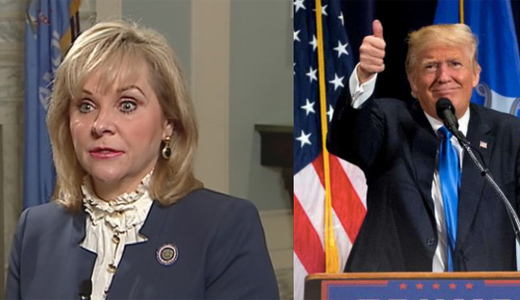
Facing a budget-busting $1.3 billion deficit, Oklahoma Governor Mary Fallin and GOP lawmakers are reversing course on Obamacare. After years of resistance, Republicans in the Sooner State are now signaling that they may finally relent in their refusal to accept the federal money for Medicaid expansion that was made available to states under the Affordable Care Act (ACA).
Currently, around 22 percent of Oklahoma’s population, or 783,000 people, are on Medicaid. If Fallin and her supporters in the state legislature can pull off their plan, 175,000 of these beneficiaries will be moved onto the private healthcare exchanges created by the ACA. This shift would then make room on Medicaid rolls for about an equal number of people who are working but still can’t afford health insurance. They would be required to pay nominal subsidized premiums and low co-pays.
As part of the ACA’s implementation in 2013, states were offered a new deal on Medicaid. Whereas previously federal and state governments split the costs of running Medicaid programs, now states that expand coverage to include working adults earning up to 138 percent of the poverty level receive federal funding to fully cover the costs for the first three years, and at least 90 percent after that.
Thirty-one states (mostly with Democratic-controlled legislatures and/or governorships) have taken the deal so far; 19 refused to budge and their people have suffered as a result. Fallin and the Oklahoma GOP have been among the most ardent in resisting federal funds. That is why this about-face, if it takes place, would amount to the biggest turnaround yet by a Republican-governed state when it comes to implementing pieces of Obamacare.
Oklahoma’s health crisis
For residents in some of the poorest areas of the state, the expansion of Medicaid cannot come soon enough. The president of the Oklahoma Hospital Association, Craig Jones, warned that the healthcare system is “nearing a colossal collapse.”
Doctors are already turning people away at many hospitals and clinics, patients with mental health issues are not receiving required treatment, and in many places hospitals are facing complete shutdowns. “This is only going to get worse,” Jones said, “if the legislature does not act immediately.”
Some of the worst conditions are found in the southeastern area of Oklahoma, where poverty rates are among the highest. At the McCurtain Memorial Hospital, for instance, 96 percent of children delivered there are born to Medicaid patients. Without the Medicaid expansion, a planned 25 percent cut to healthcare funding would probably close the hospital, according to its director, Jahni Tapley.
In some communities, that has already started to happen. At the Eastern Oklahoma Medical Center in Poteau – the only public hospital in LeFlore County – equipment was so outdated that state authorities closed the surgical and obstetrics departments for a period of time in 2014. Only an injection of more than a million dollars of new publicly guaranteed debt financing (on top of the nearly $3 million already owed by the hospital) was able to restore services. How long such an arrangement can continue is unclear.
Those from this part of the state who are able to have been crossing the state line to Arkansas to receive health services. Those who cannot afford to, however, are left with underfunded and outdated hospitals.
Oil bust plus austerity result in “revenue failure”
But the dire situation in Oklahoma’s health sector is just one slice of a statewide crisis of public services that has come in the wake of a collapse of tax revenues from the state’s oil and gas sectors. One out of every five jobs in Oklahoma is tied to energy; a 70 percent drop in crude prices has meant companies are cutting back employment and drastically curtailing the tax money they had been pumping into state coffers. The situation led Secretary of Finance Preston Doerflinger to declare a “revenue failure.”
Thressa Loyd, whose husband works on the wireline side of the oil industry, said the last couple of years have been tough for her family. “The company he was working for cut his pay by 60 percent in a matter of two months,” she told People’s World. “It was dramatic…a matter of thousands of dollars a month, with no warning. Our family had to sell our home and go from one person being the breadwinner to both of us working and taking care of our kids.” “This oil bust,” Loyd said, “has completely changed our family dynamic.”
What makes it all worse, however, is that Fallin and the GOP have for years pushed through policies that set the state up for exactly what is happening now. State Representative Scott Inman (D-Del City) told the press, “We didn’t create the proper tax structure to protect us from this type of boom-and-bust cycle.” He said the “Republican-led legislature just randomly cut different taxes thinking we’d benefit from it.”
Rather than following a sustainable taxation and funding model during the boom years that could have guaranteed fiscal security during recessions, the state legislature instead passed repeated tax cuts and shelled out corporate subsidies in a supposed effort to make the state more attractive to investors. Since 2007, the corporate subsidy watchdog Good Jobs First calculates that Oklahoma has provided over $1.5 billion in subsidies to the oil and gas sector. In an amazing – or maybe not so amazing – coincidence, this year’s budget deficit of $1.3 billion clocks in at almost the same amount.
When the oil boom began its downward spiral, public services were left in the lurch. In addition to the health crisis, Oklahoma’s public schools are also facing a severe crunch. Local school districts are resorting to a variety of tactics to stay afloat as state money dries up: four-day school weeks, teacher layoffs, and cuts to athletics, special education, bus services, and school lunch programs. Just yesterday, more than 1,000 students from schools across Oklahoma City walked out of class in protest, chanting “No budget cuts!”
The squeeze on schools is not new, though. School funding in Oklahoma, which ranks 49th in the nation in per-student spending and 48th in teacher pay, hasn’t budged for six years. Even when the oil boom was at its height, Oklahoma’s students and teachers were still being neglected by Fallin and the GOP.
Even now, with the state’s economy in a nosedive, the governor and the legislature continue to pursue an agenda which only exacerbates the situation. The most recent cut – another quarter-point reduction in the tax rate for top income earners – is expected to cost another $147 million this year. Adding to their irresponsibility and fiscal mismanagement, Republicans have also still seen fit to continue spending on a $307 million renovation of the state capitol building while the health and education sectors face collapse.
“Starving the beast”
The starvation budget approach that Fallin has pursued is not unique to Oklahoma. It is a local version of the same agenda that has been pushed by many governors across the nation.
Since the 1970s, conservatives have followed a strategy called “starve the beast,” in which they use repeated rounds of tax cuts to gradually undermine the fiscal viability of government services. The game is simple: run up the deficit and then present austerity and cuts as the only ways back to financial health. In the wake of the 2008 financial crisis and the Great Recession that has followed, they have pursued this program even more vigorously.
For Fallin though, it would appear that stuff has hit the fan, so to speak. Her approval ratings are near 40 percent and with rumors swirling that she is on Donald Trump’s shortlist as a VP candidate, the severity of Oklahoma’s budget crisis is becoming a political liability. Opportunism often trumps ideology.
As a Congresswoman, she voted against Obamacare in 2010. Now she is being forced to backtrack and accept elements of the very plan she tried to sink. Playing a game of verbal gymnastics, Fallin insists the Medicaid expansion (which is being partially funded by a tax hike on cigarettes, but of course not on incomes) is not really an expansion at all. She calls it a “Medicaid transition,” a shift of people from the public dole onto the private insurance market.
Technically, she’s correct. But the motivation behind the “transition” has more to do with accessing some of the $3.6 billion in federal funds that she earlier rejected than with fealty to the private insurance industry. (But of course, why not help them along the way as well?)
Even fellow conservatives see through the ruse of her terminology, though. The Koch Brothers-backed Americans for Prosperity, which has previously hailed Fallin as a hero of “state’s rights,” is planning a “Nobamacare” event at the Oklahoma capitol to protest her Medicaid plan.
Like the winds of a Broadway musical, austerity is sweeping down the plain in Oklahoma. But the jig is up for Mary Fallin. She’ll be holding onto the Governor’s mansion until 2018, but voters can still make a down-ticket difference in November. Only by sending the austerity agenda packing can they once more make “Oklahoma O.K.”
C.J. Atkins is the opinion editor of People’s World. He grew up in Oklahoma and attended K-12 at an underfunded, outdated public school in the state. Amanda G. Luman is a teacher living in Southeast Oklahoma and has ten years’ experience working in the social services, rehabilitation, and education sectors.
Photo: Governor Mary Fallin, Donald Trump. AP













Comments